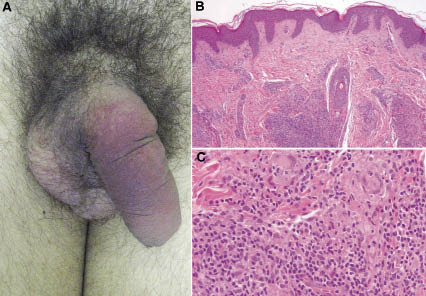Dusky Red Swelling of the Penis in Association with Fever and Diarrhoea: A Quiz
Andrea Saggini1, Andrea Chiricozzi1 and Tiago Torres2
Departments of Dermatology, 1University of Rome Tor Vergata, Viale Oxford 81, IT-00133 Rome, Italy, and 2Hospital de Santo António, Porto, Portugal. E-mail: andreasaggini@gmail.com
A 22-year-old man presented with a 4-week history of painless, persistent swelling of the penis, accompanied by fever, recurrent diarrhoea, weight loss, and increased erythrocyte sedimentation rate (ESR). The patient’s family and medical history were unremarkable; he denied taking any medications in the months prior to onset of symptoms, or ever self-injecting foreign substances in the genital area. A 10-day course of cephalexin had been ineffective.
Physical examination revealed diffuse, non-pitting induration of the shaft and dusky erythema of overlying skin (Fig. 1A); the scrotum and inguinal folds were uninvolved. Neither additional changes of skin or mucosae, nor inguinal lymphadenopathy could be seen.
A 4-mm punch biopsy specimen was obtained from the base of the penis and sent for histopathological analysis (Fig. 1B, 1C).
Fig. 1. (A) Violaceous erythema and homogeneous swelling of the penis in the absence of ulceration; the scrotum and inguinal folds are spared. (B) Diffuse involvement of the dermis by non-caseating granulomatous reaction (H&E ×40). (C) Epithelioid cells and multinucleated Langhans-type giant cells surrounded by lymphocytic collarette (H&E ×200).
What is your diagnosis? See next page for answer.
doi: 10.2340/00015555-1263
Dusky Red Swelling of the Penis in Association with Fever and Diarrhoea: Comment
Acta Derm Venereol 2011; 91: XX–XX.
Diagnosis: Metastatic Crohn’s disease of the penis associated with enteric Crohn’s disease
Histopathological evaluation revealed diffuse involvement of the dermis by non-caseating granulomatous reaction. The results of Gram’s, periodic acid-Schiff (PAS), Ziehl-Neelsen, and Grocott’s methenamine silver staining, and analysis with polarizing microscopy for foreign bodies were all negative (not shown). Total body computed tomography (CT) scan and colonoscopy showed irregular wall thickening and patchy mucosal inflammation of the large bowel, respectively. These findings were deemed consistent with a diagnosis of colonic Crohn’s disease (CD) with metastatic involvement of the penis. Therapy with prednisone (60 mg) and infliximab (5 mg/kg) led to almost complete resolution of enteric symptoms, as well as penile swelling and erythema in 3 weeks. Prednisone was subsequently tapered; the patient is in remission under continuous infliximab treatment after 6-month follow-up.
DISCUSSION
CD is a granulomatous disorder belonging to the group of inflammatory bowel disease together with ulcerative colitis (1). CD mucocutaneous manifestations, whose lifetime incidence among CD patients may be up to 75%, have been classified into non-specific changes (i.e. reactive dermatoses and abnormalities secondary to nutritional deficiencies) and granulomatous lesions (1, 2); the latter group encompasses oral CD, contiguous CD (i.e. involving the perianal area or abdominal surgical sites) and distant cutaneous (metastatic) CD (MCD) (1, 3).
By definition, MCD occurs at sites anatomically distinct from areas of gastroenteric disease (4). With less than 100 cases reported in the literature, the actual incidence of MCD is likely to be underestimated (2). In line with gastrointestinal CD, MCD typically appears between the second and fourth decades, more often in association with colonic involvement (1, 5, 6); paediatric MCD, however, is a well-known occurrence (2). No consistent correlation has ever been found between MCD and activity of bowel inflammation (1, 2, 5); importantly, in approximately 20% of reported patients skin lesions preceded any manifestations of gastroenteric inflammation (2).
Clinically, MCD may show highly polymorphic features, presenting with variable combinations of papules/plaques, skin induration/swelling, and ulceration (1, 2, 5). The genital region is involved in approximately 66–85% and 50–60% of paediatric and adult cases of MCD, respectively (2). Typical features of genital MCD are labial or scrotal and/or penile swelling, with or without accompanying erythema (1, 2); linear fissures in the inguinal folds may constitute an additional manifestation, with a predisposition to ulceration due to chronic friction and moisture (1, 2). Contiguous perianal disease may be concomitantly present in up to 50% of patients (2).
The histopathological hallmark common to gut, oral, contiguous, and metastatic CD is the presence of non-caseating granulomas standing against a background of mixed inflammatory infiltrate (7, 8). MCD granulomas often cluster around lymphatic vessels (granulomatous lymphangitis), correlating with lymphatic failure and the clinical finding of non-pitting oedema (8); inflammation and ensuing obstruction of lymphatic system have been postulated to play a key role in the pathogenesis of both enteric and metastatic CD (8–10).
MCD is regarded as a “great imitator” (1, 2, 5); an extensive panel of investigations is required to avoid diagnostic errors and treatment delays, including histopathological evaluation of bioptic specimens with polarizing microscopy and special stains for infectious organisms, tissue cultures, chest radiographs, and testing for mycobacterial hypersensitivity (2, 8). Diverging responses to the same therapeutic agents have often been observed between gut and skin in CD patients (1, 6). Effective options for MCD include combinations of topical/intralesional corticosteroids and oral metronidazole, systemic corticosteroids, non-biological immunosuppressants, and anti-tumour necrosis factor alpha (TNF-α) agents (1, 2).
REFERENCES




